科研方法与论文写作--英美文学英文版)
研究生英语学术论文写作课件

Deng Yingling Foreign Studies College of Hunan Normal University
I. Course Description
This course is an attempt to guide the students to learn more advanced skills and strategies for thinking and writing in English of a more academic nature. They are required to write course papers and dissertations which have to meet certain internationally accepted academic standards.
研究的突出主题:对美国国民性的认识、 对身份的建构、互文件导致的某些思想的 传承和渊源关系等 环境意识和生态保护意识引导着学者重新 阐释早期作品。区域文学研究、早期乡士 文学研究,与当下的环境意识和生态意识 紧密联系起来,互为补充,互为印证,表 现出很强的文化建设和思想建设性
美国小说研究存在的问题
美国小说文化研究
20世纪90年代以来文学研究的热点:从人文关怀 的角度出发,摆脱经院式研究套路,把文学研究 还置于产生这一文学现象的历史、文化、宗教、 哲学、社会、民俗的背景之中加以研究,运用现 代文化理论来审视文学现象,并给予文学文本以 文化意义上的解读和阐释。 我国对美国小说的文化研究:明显表现出对美国文 学中亚文化现象的兴趣,如犹太文化、黑人文化、 女性文化和中国文化。
浅谈英美文学方向的论文写作
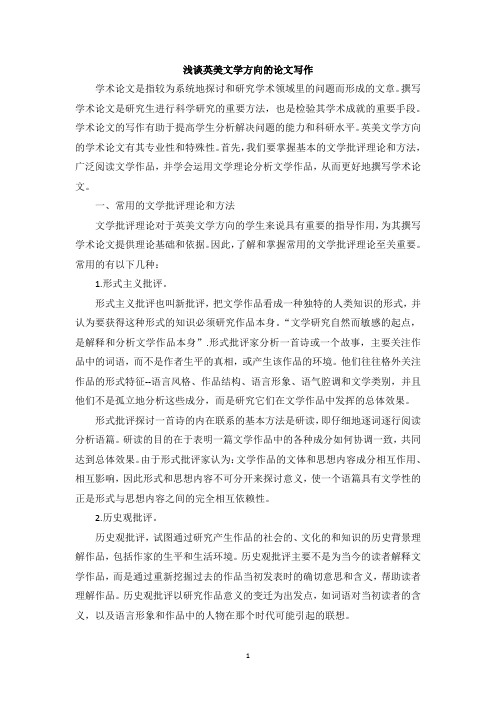
浅谈英美文学方向的论文写作学术论文是指较为系统地探讨和研究学术领域里的问题而形成的文章。
撰写学术论文是研究生进行科学研究的重要方法,也是检验其学术成就的重要手段。
学术论文的写作有助于提高学生分析解决问题的能力和科研水平。
英美文学方向的学术论文有其专业性和特殊性。
首先,我们要掌握基本的文学批评理论和方法,广泛阅读文学作品,并学会运用文学理论分析文学作品,从而更好地撰写学术论文。
一、常用的文学批评理论和方法文学批评理论对于英美文学方向的学生来说具有重要的指导作用,为其撰写学术论文提供理论基础和依据。
因此,了解和掌握常用的文学批评理论至关重要。
常用的有以下几种:1.形式主义批评。
形式主义批评也叫新批评,把文学作品看成一种独特的人类知识的形式,并认为要获得这种形式的知识必须研究作品本身。
“文学研究自然而敏感的起点,是解释和分析文学作品本身”.形式批评家分析一首诗或一个故事,主要关注作品中的词语,而不是作者生平的真相,或产生该作品的环境。
他们往往格外关注作品的形式特征--语言风格、作品结构、语言形象、语气腔调和文学类别,并且他们不是孤立地分析这些成分,而是研究它们在文学作品中发挥的总体效果。
形式批评探讨一首诗的内在联系的基本方法是研读,即仔细地逐词逐行阅读分析语篇。
研读的目的在于表明一篇文学作品中的各种成分如何协调一致,共同达到总体效果。
由于形式批评家认为:文学作品的文体和思想内容成分相互作用、相互影响,因此形式和思想内容不可分开来探讨意义,使一个语篇具有文学性的正是形式与思想内容之间的完全相互依赖性。
2.历史观批评。
历史观批评,试图通过研究产生作品的社会的、文化的和知识的历史背景理解作品,包括作家的生平和生活环境。
历史观批评主要不是为当今的读者解释文学作品,而是通过重新挖掘过去的作品当初发表时的确切意思和含义,帮助读者理解作品。
历史观批评以研究作品意义的变迁为出发点,如词语对当初读者的含义,以及语言形象和作品中的人物在那个时代可能引起的联想。
课程与教学论英语学科教学论方向培养方案

课程与教学论(英语学科教学论方向)培养方案(修改后的培养方案从2010级起执行)一、培养目标全面贯彻党和国家的教育方针,培养德、智、体全面发展的专业高层次人才,为社会主义现代化建设服务,培养高素质的外语教学科研人才。
具体要求如下:1、爱祖国,热爱社会主义,坚持四项基本原则;培养崇尚科学、勇于探索的科学精神,具有良好的职业道德及敬业精神;遵纪守法,思想品德高尚,作风端正;具有开拓创新精神、团结合作的精神和实践能力;信守学术诚信,遵守学术规范。
2、具备扎实的英语语言基本功,系统掌握本学科方向的专业知识;坚持理论联系实际,能够创造性地运用本学科理论知识解决教学和科研中遇到的问题。
3、基本掌握第二外语;计算机操作达到合格标准。
4、掌握现代教育理论知识和教育技术,具备良好的师范技能。
5、坚持锻炼,铸就坚强的毅力与健康的体魄。
二、研究方向1、外语教学理论:现代外语教学理论及其源流、母语习得与二语学习比较、影响外语教学的内外因素、学习理论与外语教学方法特征、学习者个体差异研究、学习者风格与策略研究、外语教学的环境、外语学习过程研究、外语课程设置、外语教学与测试和《课程标准》研究等。
2、现代外语教学模式:中学及高等院校听、说、读、写教学策略探讨、现代外语教学模式探讨、外语教学改革的理论与实践探索、现代外语教育技术运用。
3、跨学科研究:语言教学与教育学、心理学、社会学、语言学等的结合研究。
三、学制学制一般为3年。
全日制硕士研究生在校学习年限为2~6年,其中课程学习一年半左右;其余时间进行科学研究,完成硕士学位论文(毕业论文撰写不少于一年)。
学位论文答辩最迟在6年内完成。
提前毕业不少于二年且达到学校提前毕业规定的条件。
第一学年为专业理论知识学习;阅读本专业方向指定的必读书及参考书;第二外语及计算机通过考核。
第二学年选定主要研究方向,围绕研究方向了解本学科研究动态,查阅相关资料,完成论文开题;完成教学实践或社会实践任务。
Introduction to Research methods and academic writing

DEFINING RESEARCH
What It Takes?
• • • • • • • Creativity Open mind Curiosity Patience Persistence Positive Attitude Discipline and focus
The Importance of Methods and Methodology
“The most common error made in conducting research is overlooking the methodology, and concentrating on the conclusions. Yet if the methodology isn’t sound, the conclusions and subsequent recommendations won’t be sound.”
Welcome to the magic world of
Research Methods and Academic Writing 研究方法与学术论文写作
2014-3-18
Research MethodIntroduction
1
• Ways of Instruction: Inactive approach, with both teacher lecturing and student discussion and presentations. • Textbooks and References: • 1) 文秋芳,2001,《应用语言学研究方法与论文写 作》北京:外语教学与研究出版社。 • 2) McDonough, J. & McDonough, S. 2000.
英美文学论文研究方法
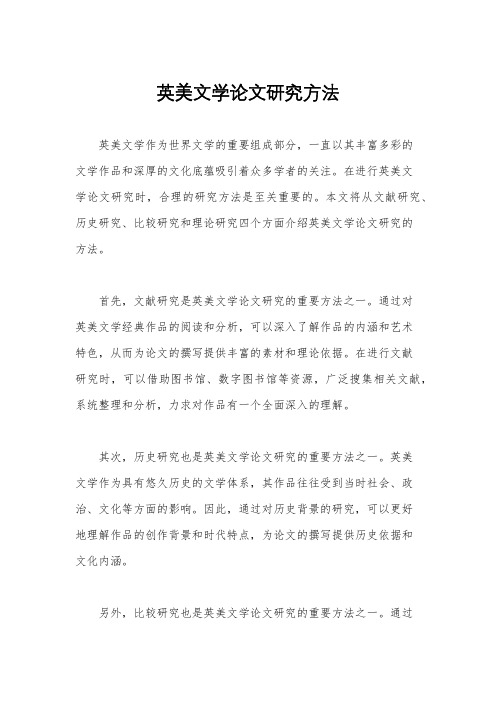
英美文学论文研究方法英美文学作为世界文学的重要组成部分,一直以其丰富多彩的文学作品和深厚的文化底蕴吸引着众多学者的关注。
在进行英美文学论文研究时,合理的研究方法是至关重要的。
本文将从文献研究、历史研究、比较研究和理论研究四个方面介绍英美文学论文研究的方法。
首先,文献研究是英美文学论文研究的重要方法之一。
通过对英美文学经典作品的阅读和分析,可以深入了解作品的内涵和艺术特色,从而为论文的撰写提供丰富的素材和理论依据。
在进行文献研究时,可以借助图书馆、数字图书馆等资源,广泛搜集相关文献,系统整理和分析,力求对作品有一个全面深入的理解。
其次,历史研究也是英美文学论文研究的重要方法之一。
英美文学作为具有悠久历史的文学体系,其作品往往受到当时社会、政治、文化等方面的影响。
因此,通过对历史背景的研究,可以更好地理解作品的创作背景和时代特点,为论文的撰写提供历史依据和文化内涵。
另外,比较研究也是英美文学论文研究的重要方法之一。
通过将英美文学作品与其他文学作品进行比较分析,可以发现不同文学体系之间的异同之处,从而深化对英美文学作品的理解和评价。
比较研究有助于拓宽研究视野,提高论文的深度和广度。
最后,理论研究是英美文学论文研究的重要方法之一。
英美文学理论体系丰富多样,包括结构主义、后现代主义、女性主义批评等多种理论流派。
通过对这些理论的学习和运用,可以为论文的撰写提供理论支持和分析框架,使论文更具学术价值和深度。
综上所述,英美文学论文研究方法包括文献研究、历史研究、比较研究和理论研究四个方面。
通过合理运用这些研究方法,可以更好地开展英美文学论文研究工作,为文学研究领域的发展做出贡献。
希望本文所述的研究方法能够为广大英美文学研究者提供一定的参考和借鉴。
最新研究生学术英语写作教程Unit-3-Reviewing-Literature
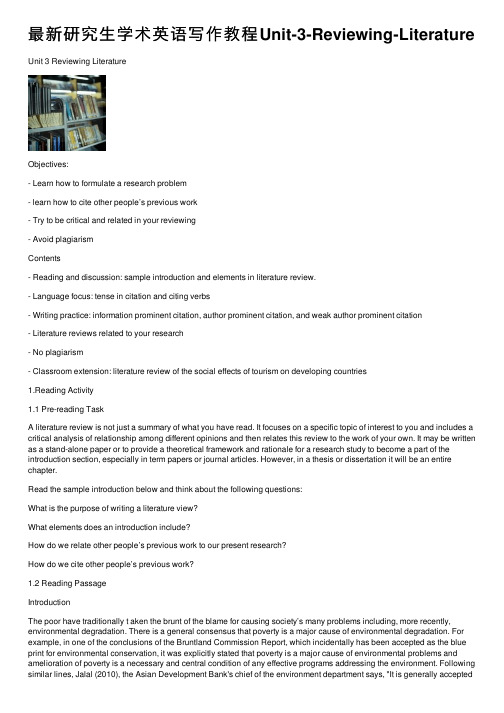
最新研究⽣学术英语写作教程Unit-3-Reviewing-Literature Unit 3 Reviewing LiteratureObjectives:- Learn how to formulate a research problem- learn how to cite other people’s previous work- Try to be critical and related in your reviewing- Avoid plagiarismContents- Reading and discussion: sample introduction and elements in literature review.- Language focus: tense in citation and citing verbs- Writing practice: information prominent citation, author prominent citation, and weak author prominent citation- Literature reviews related to your research- No plagiarism- Classroom extension: literature review of the social effects of tourism on developing countries1.Reading Activity1.1 Pre-reading TaskA literature review is not just a summary of what you have read. It focuses on a specific topic of interest to you and includes a critical analysis of relationship among different opinions and then relates this review to the work of your own. It may be written as a stand-alone paper or to provide a theoretical framework and rationale for a research study to become a part of the introduction section, especially in term papers or journal articles. However, in a thesis or dissertation it will be an entire chapter.Read the sample introduction below and think about the following questions:What is the purpose of writing a literature view?What elements does an introduction include?How do we relate other people’s previous work to our present research?How do we cite other people’s previous work?1.2 Reading PassageIntroductionThe poor have traditionally t aken the brunt of the blame for causing society’s many problems including, more recently, environmental degradation. There is a general consensus that poverty is a major cause of environmental degradation. For example, in one of the conclusions of the Bruntland Commission Report, which incidentally has been accepted as the blue print for environmental conservation, it was explicitly stated that poverty is a major cause of environmental problems and amelioration of poverty is a necessary and central condition of any effective programs addressing the environment. Following similar lines, Jalal (2010), the Asian Development Bank's chief of the environment department says, "It is generally acceptedthat environmental degradation, rapid population growth and stagnant production are closely linked with the fast spread of acute poverty in many countries of Asia". The World Bank joined the consensus when in the 2011 World Development Report, the Bank explicitly stated that, “poor families who have to meet short term needs mine the natural capital by excessive cutting of trees for firewood and failure to replace soil nutrients ” (World Bank 2011).However, there has been a rising trend in the economic literature which disputes the conventional theory and argues that simple generalizations of this multi-dimensional problem are erroneous and that a more complex set of variables are in play (Leach and Mearns, 2012). These studies point to demographic, cultural, and institutional factors as important variables in the poverty-environmental degradation nexus. An intricate web of factors plus the existence of feedback loops from environmental degradation to poverty makes the process of identifying causality links,if any, between environmental degradation and poverty a difficult exercise. However, these studies have been few and isolated and it is interesting to note that until recently, there has been very little in-depth coordinated empirical research in the economics of environmental degradation-poverty causality relationships.This brings to the purpose of this study. Both poverty and environmental degradation have been increasing in many developing countries; hence there is a pressing need first to evaluate and analyze the poverty-environmental degradation nexus, and second, to prescribe policy options to mitigate or eradicate these two problems.The primary objective of the paper is to analyze critically the existing literature on the poverty-environmental degradation nexus and try to make "some order out of the chaos" inherent in this complex and difficult subject. For this paper, our analysis is limited to the following four main natural resources which are under serious threat of degradation in many developing countries: i) forests; ii) land; iii) water; and iv) air. Biodiversity is excluded at this point because the preliminary literature search found only scattered and inconclusive information. However, it should not be inferred that biodiversity is less important than the four resources chosen; indeed it is an area which needs particular attention in the future.Once the natural resource sectors have been identified, a cause, impact and feedback analysis is carried out. In this manner, we hope first to identify the main agents and the degree of their contribution towards the destruction of the environment and second, the incentives or motivating factors encouraging their unsustainable activities. The impact and feedback analysis should highlight the main impacts arising from the degradation activities and the socio-economic effect these impacts have across the various income groups in the economy.1.3 Reading Comprehension1.3.1 List different opinions on poverty and environmental degradation/doc/b6fe811efc0a79563c1ec5da50e2524de518d0b3.html nguage Focus2.1Tense in citationPresent tense - Authors mostly use the present tense verbs to show their opinion on another person's research, relate what other authors say or discuss the literature, theoretical concepts, methods, etc. However, the simple past and present perfect are also possible verb forms in this case. Look at these examples in the present tense: ?Nelson (1995) remarksJones (2005) stressesMorison (2000) advocatesZhang (2007) claimsZhambhi (2008) arguesPast tense - When you use the past tense, the reporting verb often occurs as an integral citation. In other words, citations with past tense verbs and named researchers as subject seem to have the discourse role of providing particulars for recounting events, results found or a preceding generalization or the basis for a claim, etc. In the example below, the citation reports the results of a single study.Carlson and Benton (2007) found that as they increased the participants’stress levels, the results of their performance deteriorated.Common verbs in the past tense are: investigated, studied, compared, analyzed, found, and examined.Present perfect - The present perfect tense can be used to state that the research results are recent, expressing what has been found over an extended period in the past and up to the present to highlight the direct relevance of previous studies to the writer's own research. Look at the following example:Although the results of pervious studies showed that further research was warranted in this area, recent studies have demonstrated that educational methodology is now moving in a new direction (Jones, 2007; Karstal, 2008).2.1.1 Check the sample introduction and complete the following table.2.2Citing verbsIt is important that you learn how to cite information in a correct way. There are certain conventions to follow when citing someone’s work. Words like “say”,“tell”, and “ask” are normally used in oral conversation s but are not appropriate in formal academic writing. The following table illustrates some appropriate words to use for reporting the work of others.Verbs for sayingJalal (1993) claimsbelievesthinksassumesindicatesnotesremarksstatesshowspoints outthat …More Verbs for sayingJalal’s (1993) study suggestsconsidershypothesizesconcludescommentsemphasizesillustratesproposesestablishesmaintainsthat…Verbs responding to others’opinionsThe analysis of the Jalal’s report accepts admitsagreesdoubtsthat …deniesarguescomments Verbs for saying a second time Jalal (1993) further/additionally asserts explainsconfirmsmaintainsadvocatesthat …Poor patterns show that the writer has a mere grasp of the literature:Jalal (1993) says that …The Asian Development Bank (1992) states that … Leach and Mearns (1995) argue that …Better sample shows some critical thinking and sentence variety:Jalal (1993) reports that his study of … shows … The findings are supported by the Asian Development Bank (1992) replication of … Although both these studies focus on …. They have ignored … According to Leach and Mearns (1995), …2.2.2 Read three extracts on the issue of poverty and crime. Use the verbs above to cite opinions on poverty and crime.3. Writing Practice3.1 Using referencesUse citation to develop your own argument.Below are examples of parts of paragraphs using three different citation methods (The references cited have been invented for demonstration purposes only). Thesemethods can be called information prominent, where the focus of the sentence is only on the information being presented; author prominent, where the name of the author of the information is given prominence in the sentence; and weak author prominent, where the ideas of author(s) are given prominence, but authors’ names do not appear in the main part of the sentence. Observe how the different methods contribute to the way in which the writer’s argument is developed.Information prominent citationShrinking markets are also evident in other areas. The wool industry is experiencing difficulties related to falling demand worldwide since the development of high-quality synthetic fibers (Smith, 2000).This is the default style in many areas of science. However, there are two other options, which should also be part of a writer’s repertoire, for use when appropriate. Author prominent citationShrinking markets are also evident in other areas. Smith (2000) argued that the wool industry was experiencing difficulties related to falling demand worldwide since the development of high-quality synthetic fibers. However, Jones et al. (2004) found that industry difficulties were more related to quality of supply than to demand issues. It is clear that considerable disagreement exists about the underlying sources of these problems.Weak author prominent citationShrinking markets are also evident in other areas. As Smith (2000) pointed out, the wool industry is experiencing difficulties related to falling demand worldwide since the development of high-quality synthetic fibers.3.1.1 The following is a chart describing people living on less than 1.25 dollars.Look at the following chart and practice citing these figures by using three different types of citation.Figure: Poverty headcount ratio at $1.25 a day (% of population)Created By Swati Revankar from World Bank, 2012 Information prominent citationAuthor prominent citationWeak author prominent citation3.2 Relating literature to your researchIt is easy to write a bad literature review and difficult to write a good one. The main mistake that a lot of people make is to write a literature review that looks like this:LITERATURE REVIEWUntil recently many researchers have shown interest in the field of coastal erosion and the resulting beach profiles. They have carried out numerous laboratory experiments and field observations to illuminate the darkness of this field. Their findings and suggestions are reviewed here.JACHOWSKI (2008) developed a model investigation conducted on the interlocking precast concrete block seawall. After a result of a survey of damages caused by the severe storm at the coast of USA, a new and specially shaped concrete block was developed for use in shore protection. This block was designed to be used in a revetment type seawall that would be both durable and economical as well as reduce wave run-up and overtopping, and scour at its base or toe. It was proved that effective shore protection could be designed utilizing these units.HOM-MA and HORIKAWA (2008) studied waves forces acting on the seawall which was located inside the surf zone. On the basis of the experimental results conducted to measure waves forces against a vertical wall, the authors proposed an empirical formula of wave pressure distribution on a seawall. The computed results obtained by using the above formula were compared well with the field data of wave pressure on a vertical wall.SELEZOV and ZHELEZNYAK (2009) conducted experiments on scour of sea bottom in front of harbor seawalls, on the basis of the theoretical investigation of solitary wave interaction with a vertical wall using Boussinesque type equation. It showed that the numerical results were in reasonable agreement with laboratory experimental data.3.2.1 Consider again the purposes of writing a literature review. See if you can answer the following questions about the literature review above:1. What questions does this literature review answer?2. What questions doesn't it answer?3. Which method has the writer used to organize the literature review?4. Is it a good literature review? Why?3.3 Avoiding plagiarism3.2.1 Below are two versions of the same information, adapted from the Introduction by McNeill et al. (2007). Decide which version has the problem of plagiarism and identify where the writer has plagiarizedVersion 1:Russell and Fillery (2006), using a stem-feeding technique, have shown that in situ 15N-labelling of lupin plants growing in soil cores enabled total belowground N to be estimated under relatively undisturbed conditions, but they indicated that the technique was not adaptable to all plants, particularly pasture species.Version 2:Russell and Fillery (2006), using a stem-feeding technique, have shown that insitu 15N-labelling of lupin plants growing in soil cores enabled total belowground N to be estimated under relatively undisturbed conditions. However, this technique is not adaptable to all plants, particularly pasture species.4. Writing ProjectWrite a literature review for your research by the following steps:1. Problem formulation—which topic or field is being examined and what are its component issues?2. Literature search—finding materials relevant to the subject being explored3. Data evaluation—determining which literature makes a significant contribution to the understanding of the topic4. Analysis and interpretation—discussing the findings and conclusions of pertinent literature5. Relate the review to your research topicYou are preparing to write an essay entit led “The social effects of tourism on developing countries”. Read the following abstract and then try to write a literature review relating to the topic according to the above mentioned steps:AbstractTourism is the fastest growing industry internationally. Popular areas of study are the economic, environmental and sociocultural impacts of tourism in developing countries. Very few studies have been conducted on the impact of tourism on the hosts’ health status. Nowadays, the emergence of new infectious diseases or there-emergence of diseases are causing concern and travel is a major contributor to their spread. The objectives of this study were: to review literature related to the topic as a background for future research; to explore if findings from a field trip to Easter Island/Chile and Peru support the hypotheses derived from the analysis of publications; to recommend a range of research topics based on the outcome of this study; and to propose elements of a framework for the assessment of health impacts of tourism. The findings suggest that there are considerable gaps in the current knowledge on tourism’s health impacts. Potential indirect and direct health impacts have been identified. Workplace health and safety concerns in relation to local tourism employees have been raised. A wide range of research topics has been suggested based on these findings. Finally, elements of a possible framework for understanding tourism’s health impacts and their interrelationships have been identified.Sources from: Irmgard Bauer, THE JOURNAL OF TOURISM STUDIES Vol. 10, No. 1, MAY ‘99 115. Final ChecklistHere is a final checklist for writing Introduction (including literature review). Use it to check what you have written in the previous task.。
论文研究方法 英文
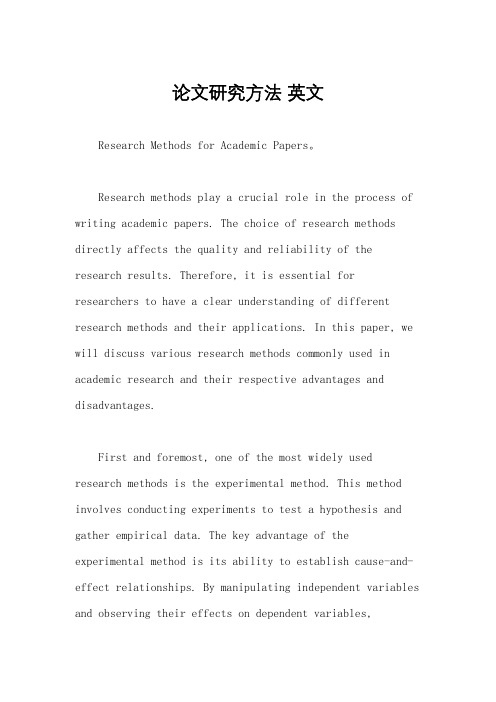
论文研究方法英文Research Methods for Academic Papers。
Research methods play a crucial role in the process of writing academic papers. The choice of research methods directly affects the quality and reliability of the research results. Therefore, it is essential for researchers to have a clear understanding of different research methods and their applications. In this paper, we will discuss various research methods commonly used in academic research and their respective advantages and disadvantages.First and foremost, one of the most widely used research methods is the experimental method. This method involves conducting experiments to test a hypothesis and gather empirical data. The key advantage of the experimental method is its ability to establish cause-and-effect relationships. By manipulating independent variables and observing their effects on dependent variables,researchers can draw valid conclusions about the relationships between variables. However, the experimental method may be limited by ethical considerations and practical constraints, such as time and resources.Another important research method is the survey method. Surveys involve collecting data from a large number of respondents through questionnaires or interviews. This method is particularly useful for gathering information about attitudes, opinions, and behaviors of a specific population. Surveys are relatively cost-effective and can provide valuable insights into the target population. However, the survey method may be susceptible to response bias and sampling errors, which can affect the reliability of the research findings.In addition to the experimental and survey methods, the qualitative research method is also widely used in academic research. Qualitative research focuses on exploring and understanding complex social phenomena through in-depth interviews, observations, and analysis of textual data. This method is valuable for gaining a deeper understandingof the underlying reasons and motivations behind certain behaviors or phenomena. However, qualitative research maybe criticized for its subjective nature and lack of generalizability.Furthermore, the quantitative research method isanother important approach to academic research.Quantitative research involves the collection and analysisof numerical data to test hypotheses and answer research questions. This method allows researchers to quantify relationships between variables and draw statistical inferences. The main strength of quantitative research isits ability to produce objective and generalizable findings. However, quantitative research may overlook the richnessand complexity of social phenomena.In conclusion, the choice of research methods is a critical decision for researchers in the process of writing academic papers. Each research method has its own strengths and limitations, and the selection of a suitable method depends on the research questions, objectives, and the nature of the research topic. By understanding thecharacteristics and applications of different research methods, researchers can enhance the quality and rigor of their academic research. It is important for researchers to carefully consider the appropriateness of research methods in order to produce valid and reliable research findings.。
科研方法:How to Write a Scientific Paper 中文版

What is a scientific paper?
What is a scientific paper? 什么是科技论文?
A paper is an organized description of hypotheses, data and conclusions, intended to instruct the reader. Papers are a central part of research. If your research does not generate papers, it might just as well not have been done. “Interesting and unpublished” is equivalent to “non-existent.” 科技论文是集假说、数据 和结论为一体的概括性描 述,以此向读者论述。论 文是研究工作的中心部分。 如果你的研究没有写成论 文,也就等同于没有做研 究。有意义但没有发表, 等同于不存在。
How should you construct an outline?
How should you construct an outline? 你应该如何起草你的提要?
The classical 最经典的方法就是找 approach is to start 一页空白的纸,以任 with a blank piece of 何顺序,写下与这篇 paper, and write down, 文章有关的所有重要 in any order, all 观点。 important ideas that occur to you concerning the paper.
The reason for outlines
关于英美文学论文范文

关于英美文学论文范文英美文学经历了很长的历史时期,并且每一个历史时期都有其著名的代表作和作品,成为了世界文学史上的宝贵的财富。
下文是店铺为大家整理的关于英美文学论文范文的内容,欢迎大家阅读参考!关于英美文学论文范文篇1浅谈英美文学的翻译方法在过去的英美文学的学习过程之中,我们通常将我们的著作划分成美国文学和英国的文学。
然而两部分文学著作,又需要从不同的时期写出不同年代的故事,我们所学习的欣赏是从流派的代表作和作家入手,分为文学著作,文学的派别以及文学潮流,对于英美文学的赏析,作品是相当的多,我们只能够挑选出作品简略阐释。
随着我国社会经济的发展,一些“实用性”课程的出现,其地位逐渐被边缘化。
面对当前的形势,作者试图从兴趣着手,结合教学实践,对文学课教学内容与教学方法的改革谈谈看法。
译者的文化选择与其采取的翻译策略是密切相关的,由于受主体文化的影响,许多译者大都有意无意间认同主体文化并采取一定的策略实现自己的文化选择。
关键词:高校英语专业、英美文学课、教学内容、教学方法根据美学的观点,任何作家的创作都有其隐含的读者,英国文艺理论家伊格尔顿也有类似的观点,“接受是作品自身的构成部分,每部文学作品的构成都出于对其潜在可能的读者的意识,……作品的每一种姿态里都含蓄地暗示着它所期待的那种接受者。
在大学中我们学习到的英美文学课程,是我们高校英语中非常重要的课程,要培养学生的阅读还有写作能力的,了解英语文学的能力,去了解一下文学的知识还有方法,通过阅读的形式了解东西方文化的差异,提高学生们的语言功力,提高学生的理解能力。
随着我们语言学习能力的提高,我们学习的课程多方面的出现,这使得文学课程逐渐的边缘化。
如何才能够在当今的学习中立于不败之地,我认为,提高学生们的兴趣是非常重要的,吸引学生的注意力,才可以提高们的兴趣,因为兴趣可以带领我们走的很远。
因此,带着兴趣学习,针对如下的几个问题,讲述一下自己的观点。
一、教学内容英美文学的学习,主要由两个大部分构成主要内容,一部分是英美国文学作品,另一部分是英美国文学历史。
英美文学论文研究方法

英美文学论文研究方法英美文学作为世界文学的重要组成部分,其研究方法对于文学研究者来说至关重要。
在进行英美文学论文研究时,我们需要掌握一定的研究方法,以便更好地理解和分析文学作品,揭示其中蕴含的文化、历史和思想内涵。
本文将介绍几种常用的英美文学论文研究方法,帮助读者更好地开展相关研究工作。
首先,文学作品的文本分析是英美文学论文研究的基础。
文本分析是指对文学作品的语言、结构、风格等方面进行深入分析,以揭示作品内在的意义和特点。
在进行文本分析时,研究者需要注重对作品的细节进行观察和解读,例如对于小说的情节安排、人物塑造、语言运用等方面进行分析,对于诗歌则需要注重韵律、节奏、意象等方面的分析。
通过文本分析,研究者可以深入理解作品的内涵,为后续的研究工作奠定基础。
其次,历史背景和文化语境的分析也是英美文学论文研究的重要方法之一。
英美文学作为具有深厚历史和文化底蕴的文学体裁,其作品往往受到当时社会、政治、文化等方面的影响。
因此,研究者需要对作品所处的历史时期和文化环境进行深入了解和分析,以便更好地理解作品的创作背景和内在含义。
通过对历史背景和文化语境的分析,研究者可以更好地把握作品的特点和意义,为文学论文的撰写提供有力支持。
此外,比较研究也是英美文学论文研究的重要方法之一。
通过对不同作品、不同作者、不同时期的文学作品进行比较分析,可以帮助研究者深入理解作品的特点和内涵,发现其共性和差异性。
比较研究可以为研究者提供更广阔的视野和更深入的思考,有助于提升论文的深度和广度。
最后,理论研究也是英美文学论文研究的重要方法之一。
文学理论的运用可以帮助研究者更好地分析和解读文学作品,揭示其中的文学美学和思想内涵。
在进行英美文学论文研究时,研究者可以结合相关的文学理论,对作品进行深入分析和解读,为论文的撰写提供理论支持。
综上所述,英美文学论文研究方法涉及文本分析、历史背景和文化语境的分析、比较研究以及理论研究等多个方面。
研究者可以根据具体的研究对象和目的,灵活运用这些方法,以便更好地开展英美文学论文研究工作,为文学研究领域的发展做出贡献。
文学英语论文范文3篇
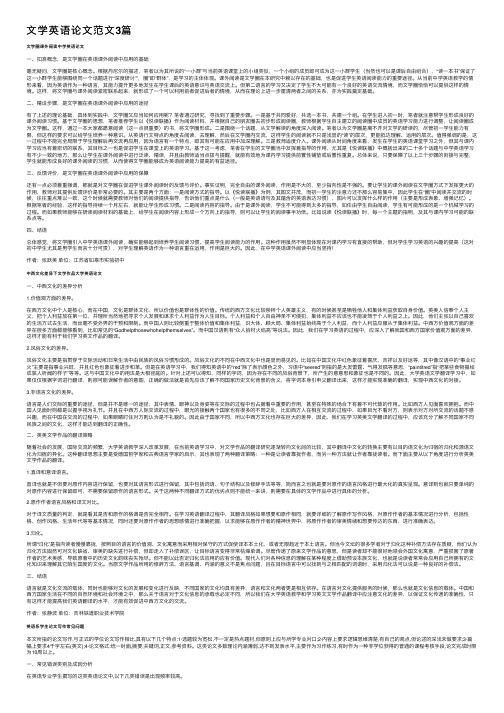
⽂学英语论⽂范⽂3篇⽂学圈课外阅读中学英语论⽂⼀、扣准概念,是⽂学圈在英语课外阅读中应⽤的基础毫⽆疑问,⽂学圈是核⼼概念。
根据丹尼尔的描述,笔者以为其所说的“⼀⼩群”与当前英语课堂上的⼩组类似,⼀个⼩组的成员即可成为这⼀⼩群学⽣(当然也可以是课后⾃由组合),“读⼀本书”保证了这⼀⼩群学⽣能够围绕同⼀个话题进⾏“深度研讨”“,圈”即“群体”,是学习的主体体现。
课外阅读是⽂学圈在本研究中赖以存在的基础,也是促进学⽣英语阅读能⼒的重要途径。
从当前中学英语教学的情形来看,因为英语作为⼀种语⾔,其能⼒提升更多地发⽣在学⽣课后的英语意识与英语交流上。
但第⼆语⾔的学习⼜决定了学⽣不⼤可能有⼀个良好的英语交流情境,⽽⽂学圈恰恰可以提供这样的情境。
这样,将⽂学圈与课外阅读紧密联系起来,就形成了⼀个可以利⽤前者促进后者的情境,从⽽在理论上进⼀步厘清两者之间的关系,亦为实践奠定基础。
⼆、精设步骤,是⽂学圈在英语课外阅读中应⽤的途径有了上述的理论基础,具体到实践中,⽂学圈⼜应当如何应⽤呢?笔者通过研究,寻找到了重要步骤。
⼀是基于共同爱好,共选⼀本书,共建⼀个组。
在学⽣进⼊初⼀时,笔者就注意帮学⽣形成良好的课外阅读习惯。
基于⽂学圈的思想,笔者推荐学⽣以《悦读联播》作为阅读材料,并根据⾃⼰的朋友圈去初步形成阅读圈,教师根据学⽣⾃主建⽴的阅读圈中成员的英语学习能⼒进⾏调整,让阅读圈成为⽂学圈。
这样,通过⼀本⼤家都愿意阅读(这⼀点很重要)的书,将⽂学圈形成。
⼆是围绕⼀个话题,从⽂学解读的⾓度深⼊阅读。
笔者以为⽂学圈是离不开对⽂学的研读的,尽管初⼀学⽣能⼒有限,但这样的要求可以给学⽣培养⼀种意识。
从英语⾏⽂特点的⾓度去阅读,去理解,然后在⽂学圈内交流,这样学⽣的阅读就不只是浅显的“读”的层次,更能抵达理解、运⽤的层次。
值得强调的是,这⼀过程中不能完全局限于学⽣理解后再交流再应⽤,因为语⾔有⼀个特点,即其有可能在应⽤中加深理解。
三是教师适度介⼊。
中国农业大学2010年学术型硕士研究生参考书目

2010年硕士招生考试参考书目汇总表考试科目240二外日语241二外法语360高等代数724马克思主义理论725传播学原理(传播学概论、传播学研究方法、传播学史)726基础英语727管理学综合(含公共管理学、管理学原理)728社会学理论729中国通史(1840 年以前)730科学思想史731经济法综合806生物化学807环境化学与环境监测809地理信息系统(含遥感原理)810气象学与气候学815土壤学与植物营养学817农村发展与管理综合818经济法学820电路原理821数据结构823普通生态学825思想政治教育理论和方法826专业综合(含影视、美学、文学)828社会学研究方法829英语写作与翻译832工程力学(理力、材力)833电子技术834水文学835食品科学基础839信息管理与情报学基础840农业概论842马克思主义哲学845农业生物环境原理847水力学848工程流体力学851结构力学852土地资源管理853城市规划原理复试:①传播实务;②文艺理论基础(同等学力考生加试科目)复试:大学化学实验复试:植物生理学(含笔试、面试、实验技能操作)复试:分子生物学(含笔试、面试、实验技能操作)复试:普通生物学(含笔试、面试、实验技能操作)复试:半导体物理学(三选一)复试:大学物理实验(三选一)复试:光谱分析技术及应用(三选一)复试:数据库原理,软件工程,上机操作复试:内容中分子生物学复试:内容中植物生理学复试:农药学概论复试:动物繁殖学复试:社会保障综合复试:信息检索与利用参考书新版中日交流标准日本语. 初级 / 人民教育出版社, 光村图书出版株式会社合作编写.-- 北京 : 人民教育出版社, 2005. -- 2册新版中日交流标准日本语. 中级上册 / 人民教育出版社, 光村图书出版株式会社合作编写.-- 北京 : 人民简明法语教程 = Cours de francais accelere / 孙辉编.-- 2版.-- 北京 : 商务印书馆, 2006高等代数 / 丘维声编.-- 2版.-- 北京 : 高等教育出版社, 2002-2003辨证唯物主义和历史唯物主义原理 / 李秀林, 王于, 李淮春主编. -- 5版. -- 北京 : 中国人民大学出版社, 2004马克思主义政治经济学原理 / 张雷声主编.-- 北京 : 中国人民大学出版社, 2003传播学教程 / 郭庆光著.-- 北京 : 中国人民大学出版社, 1999传播学研究方法 / 李红艳著.-- 北京 : 中国传媒大学出版社, 2008中国新闻传播史 / 方汉奇主编 ; 丁淦林, 黄瑚, 薛飞著.-- 北京 : 中国人民大学出版社, 2002外国新闻传播史 / 郑超然, 程曼丽, 王泰玄著.-- 北京 : 中国人民大学出版社, 2000语言学教程 / 胡壮麟主编. -- 北京 : 北京大学出版社,2002西方语言学流派 / 刘润清编著. -- 2版. -- 北京 : 外语教学与研究出版社, 2002应用语言学研究方法与论文写作 = Applied linguistics : Research methods and thesis writing / 文秋芳著.-- 北京 : 外语教学与研究出版社, 2001文化、文学基础知识类读物(1-2册)公共管理学 / 张成福, 党秀云著.-- 2版.-- 北京 : 中国人民大学出版社,2007管理学 / 王凤彬, 李东编著. -- 3版.-- 北京 : 中国人民大学出版社, 2007社会学与生活 = Sociology / (美) 理查德·谢弗(Richard T. Schaefer)著 ; 刘鹤群, 房智慧译. -- 北京: 世界图书出版公司北京公司, 2006论人类学与文化自觉 / 费孝通著. -- 北京 : 华夏出版社, 2004文化的表达 : 人类学的视野 = The expression of culture : perspectives of anthropology / 赵旭东著. -- 北京 : 中国人民大学出版社, 2009中国古代简史 / 张帆著.-- 北京 : 北京大学出版社, 2001简明中国古代史 / 张传玺主编 ; 张仁忠 … [等] 编.-- 2版.-- 北京 : 北京大学出版社, 1994科学的历程 / 吴国盛著.-- 2版.-- 北京 : 北京大学出版社, 2002科学技术史 / 李思孟,宋子良主编. -- 武汉 : 华中理工大学出版社, 2000行政法与行政诉讼法 / 姜明安主编 ; 于安 … [等] 撰稿. -- 3版.-- 北京 : 北京大学出版社,2007民事诉讼法 = Civil procedural law / 江伟主编.-- 3版. -- 北京 : 高等教育出版社,2007民法 / 魏振瀛主编 ; 王成 … [等] 撰稿. -- 3版.-- 北京 : 北京大学出版社,2007法理学 = Jurisprudence / 张文显主编. -- 3版.-- 北京 : 高等教育出版社 : 北京大学出版社, 2007生物化学 / 王镜岩, 朱圣庚, 徐长法主编.-- 3版.-- 北京 : 高等教育出版社,2002环境化学 / 戴树桂主编. -- 2版.-- 北京 : 高等教育出版社, 2006环境监测 / 奚旦立, 孙裕生, 刘秀英合编. -- 3版.-- 北京 : 高等教育出版社,2004地理信息系统 : 原理、方法和应用 / 邬伦 … [等] 编著. -- 北京 : 科学出版社, 2001遥感概论 / 彭望琭主编. -- 北京 : 高等教育出版社,2002气象学与气候学 / 周淑贞主编. -- 3版. -- 北京 : 高等教育出版社,1997大气物理学 / 盛裴轩 … [等] 编著. -- 北京 : 北京大学出版社,2003现代气候学概论 / 王绍武 … [等] 编著. -- 北京 : 气象出版社, 2005植物营养学.上册 / 陆景陵主编. -- 2版.-- 北京 : 中国农业大学出版社,2003植物营养学.下册 / 胡霭堂主编. -- 2版.-- 北京 : 中国农业大学出版社,2003土壤学 / 吕贻忠, 李保国主编. -- 北京 : 中国农业出版社,2006普通发展学 = Introduction to development studies / 李小云主编.-- 北京 : 社会科学文献出版社,2005参与式发展规划 = Participatory development planning / 叶敬忠, 刘燕丽, 王伊欢编著.-- 北京 : 社商法学 = Commercial law / 赵旭东主编. -- 北京 : 高等教育出版社,2007经济法学 = Economic law / 李昌麒主编. -- 北京 : 法律出版社,2007环境与资源保护法 / 周珂主编 ; 王灿发 ... [等] 撰稿.-- 北京 : 中国人民大学出版社,2007电路 / 邱关源主编.-- 4版.-- 北京 : 高等教育出版社, 1999数据结构及算法 / 彭波编著.-- 北京 : 机械工业出版社,2008数据结构教程 / 彭波编著.-- 北京 : 清华大学出版社,2004基础生态学 / 孙振钧,王冲主编. -- 北京 : 化学工业出版社, 2007基础生态学 / 牛翠娟 … [等] 编著. -- 2版. -- 北京 : 高等教育出版社, 2007思想政治教育学原理 / 邱伟光, 张耀灿主编 ; 教育部社会科学研究与思想政治工作司组编. -- 北京 : 高等教育出版社, 1999电影学 = Movie / 刘宏球著. -- 杭州 : 浙江大学出版社, 2006美学教程 / 王一川主编. -- 上海 : 复旦大学出版社, 2004中国现代文学三十年 / 钱理群, 温儒敏, 吴福辉著. -- 北京 : 北京大学出版社, 1998社会调查研究方法 / 张蓉主编. -- 北京 : 高等教育出版社, 2005社会研究的统计应用 / 李沛良著. -- 北京 : 社会科学文献出版社,2001人类学的四大传统 : 英国、德国、法国和美国的人类学 / (挪)弗雷德里克·巴特(Fredrik Barth) ... [等] 著 ; 高丙中 ... [等] 译. -- 北京 : 商务印书馆, 2008英语科研论文写作概要 = Essential strategies for English academic writing / 冯翠华编著. -- 上海: 上海外语教育出版社, 2003MLA科研论文写作规范 / [英]Joseph Gibaldi著. -- 上海 : 上海外语教育出版社, 2001英汉互译实践与技巧 / 许建平编著. -- 2版.-- 北京 : 清华大学出版社, 2003材料力学.I / 刘鸿文主编.-- 4版.-- 北京 : 高等教育出版社,2004 (也可参考3版)材料力学.上册 / 刘鸿文主编. -- 3版.-- 北京 : 高等教育出版社,1992理论力学.Ⅰ / 哈尔滨工业大学理论力学教研室编.-- 6版.-- 北京 : 高等教育出版社,2002电子技术基础. 模拟部分 / 康华光主编 ; 华中科技大学电子技术课程组编.-- 5版.-- 北京 : 高等教育出版社, 2006工程水文学与水利计算 / 任树梅, 程伍群,魏永霞主编.-- 2版.-- 北京 : 中国农业出版社, 2008食品工程原理 / 李云飞,葛克山主编. -- 北京 : 中国农业大学出版社, 2002化工原理 / 陈常贵,柴诚敬,姚玉英编著. -- 2版. -- 天津 : 天津大学出版社,2004食品化学 / 阚建全主编. -- 2版. -- 北京 : 中国农业大学出版社, 2008信息管理概论 = Introduction to information management / 柯平, 高洁主编.-- 2版.-- 北京 : 科学出版社, 2007农业概论 / 翟虎渠主编.-- 2版.-- 北京 : 高等教育出版社, 2006马克思主义哲学原理 / 袁贵仁主编.-- 3版.-- 北京 : 北京出版社, 2003马克思主义哲学原理 / 陈先达主编.-- 2版.-- 北京 : 中国人民大学出版社, 2004农业生物环境原理 / 鲁纯养主编.-- 北京 : 农业出版社,1994水力学 / 吴持恭主编 ; 高速水力学国家重点实验室(四川大学)编.-- 3版.-- 北京 : 高等教育出版流体力学 / 罗惕乾主编.-- 3版.-- 北京 : 机械工业出版社,2007结构力学. Ⅰ, 基本教程 / 龙驭球,包世华主编. -- 2版. -- 北京 : 高等教育出版社, 2006结构力学. Ⅱ, 专题教程 / 龙驭球,包世华主编. -- 2版. -- 北京 : 高等教育出版社, 2006土地资源学 / 刘黎明主编. -- 4版.-- 北京 : 中国农业大学出版社,2004土地管理学 / 朱道林主编. -- 北京 : 中国农业大学出版社, 2007土地利用规划学 / 郝晋珉主编. -- 北京 : 中国农业大学出版社, 2007土地经济学 / 刘书楷, 曲福田主编. -- 2版.-- 北京 : 中国农业出版社, 2004地籍管理(不指定具体参考书)城市规划原理 / 李德华主编.-- 3版.-- 北京 : 中国建筑工业出版社, 2001电影学 = Movie / 刘宏球著.-- 杭州 : 浙江大学出版社, 2006美学教程 / 王一川主编.-- 上海 : 复旦大学出版社,2004中国现代文学三十年 / 钱理群, 温儒敏, 吴福辉著.-- 北京 : 北京大学出版社, 1998新编大学化学实验 / 浙江大学,华东理工大学,四川大学合编,殷学锋主编.-- 北京 : 高等教育出版社,植物生理学 / 武维华主编.-- 2版.-- 北京 : 科学出版社,2008分子生物学 / 阎隆飞,张玉麟主编.-- 2版.-- 北京 : 中国农业大学出版社,1997微生物生物学 / 杨苏声,周俊初主编.-- 北京 : 科学出版社,2004现代微生物遗传学 / 陈三凤,刘德虎编著.-- 北京 : 化学工业出版社 : 现代生物技术与医药科技出版中半导体物理学 / 刘恩科,朱秉升,罗晋生编著.-- 7版.-- 北京 : 电子工业出版社,2008大学物理实验教程 / 戴允玢,张连娣,王家慧编著.-- 2版.-- 北京 : 机械工业出版社,2006光谱分析技术及其应用 / 李民赞主编.-- 北京 : 科学出版社,2006数据库理论及应用基础 / 汤庸, 叶小平, 汤娜编著.-- 北京 : 清华大学出版社, 2004软件工程 / 钱乐秋, 赵文耘, 牛军钰编著.-- 北京 : 清华大学出版社, 2007分子生物学 / 阎隆飞, 张玉麟主编. -- 2版.-- 北京 : 中国农业大学出版社,1997植物生理学 / 武维华主编.-- 2版.-- 北京 : 科学出版社, 2008农药概论 / 韩熹莱主编.-- 北京 : 北京农业大学出版社,1995家畜繁殖学 / 张忠诚主编.-- 4版.-- 北京 : 中国农业出版社,2004社会保障理论 = Theory of social security / 李珍主编.-- 2版.-- 北京 : 中国劳动社会保障出版社, 2007信息检索 / 焦玉英, 符绍宏, 何绍华编著. -- 武汉 : 武汉大学出版社, 2001农业信息检索与利用 / 左文革, 吴秀爽主编. -- 北京 : 中国农业出版社, 2006备注。
英国文学选读论文格式及要求

件:封面样式(空两行)《英美文学选读》课程论文论文题目(宋体小二)(副标题宋体四号)姓名:班级:学号:(以上四项用宋体四号字)年月日(黑体3号字)《英国文学选读》学期论文指导写作一、学期论文的要求:期末考试时上交, 《英国文学选读》相关作品, 按正规论文格式, A4打印稿。
1200 words, 包括:题目,中英文摘要, 关键词, 正文分论述层次,参考文献。
谢绝抄袭和剽窃!二、论文的考察目的通过论文的写作,考查学生分析问题和运用基本理论解决问题的能力,同时引起学生对该门课程前沿理论和热点问题的关注,提高阅读和分析英国文学作品的能力,锻炼学生的写作能力,提高学生的理论素养和水平。
三、论文的选题论文题目的选定必须注意四个准则:必须对此课题有浓厚的学术兴趣,在力所能及的范围内有充分的参考资料可供使用,应有能力收集、组织和利用这些材料,能够应用科研的方法实施研究计划。
四者缺一不可,否则就有半途而废的可能。
通过对课程的学习,除对本课程知识有了整体的把握以外,对课程的某些问题会产生深入探究的兴趣,这就是研究性学习的基础。
论文题目的确定应该是在围绕自己感兴趣的问题进行深入阅读的过程中产生的。
在学术工作中,论文的题目就是研究的课题或课题研究的一部分。
课题的选择除了客观因素外,与一个研究人员的业务素质和认识能力有很大的关系。
著名科学家贝尔纳说过:“课题的形成和选择,无论是作为外部的技术经济要求,抑或作为科学本身的要求,都是科研工作中最复杂的一个阶段。
一般来说提出课题比解决课题更困难。
”选题,也就是发现问题。
因此,人们常说,确定了研究课题,等于研究工作完成了一半,这就是在强调选题定题的重要性。
每一个学科都有自己的基础理论、历史发展和方法技术,也都有基础研究、应用研究和开发研究。
每个方面,只要钻进去,都有许多课题可以探讨与研究。
一个课题解决了,又会出现新的课题,科学是无止境的。
随着科学研究的深入,科研工作的分工越来越细,每一个人如果能够在专业领域内某一问题上有所发现,有所突破,就是非常可喜的了,不可能什么都明白。
大学英语专业毕业论文英美文学方向选题

外国语学院英语专业2005级毕业论文选题参考题目英美文学研究方向选题On the Biblical A l legoryllegory in the Pilgrim’s ProgressOn the Searching for I dentity in Toni Morrison’s “Song of Solomon”Study on the Resistance in Allen Ginsberg’s “Howl”PoemsStudy on Death in Emily Dickinson’sStudy on B uddhismBuddhism in Emerson’s “Nature”Study on the V i olenceiolence in Flannery Oconnor’s Short StoriesStudy on the Symbols in Coleridge’s “The Rime of the Ancient Mariner”Study on the Distortion in Edward Albee's “Who's Afraid of Virginia Woolf?”Study of Symbolism i n Hemingway’s “The Old man and the sea”Study on Edgar Allan Poe’s Short StoriesLove, Equality and Tolerance—On the Nature of Love of Jane and TessHenry's Short StoriesOn the Endings and Features of O ·Paradise Lost—The War in the HeavenJane Austen's Marriage Conception in Pride and PrejudiceA Brief Approach to the Influence of the Religion on LiteratureA Study on the Characterization of Great ExpectationsIndividual Has Integrated into the Society—An Analysis of Hester in The Scarlet LetterThe Stream-of-Consciousness Techniques Used in UlyssesThe Attractions of The Waste LandOn the Religious Color of Characterization in Uncle Tom's CabinAn Unfortunate but Strong Woman —An Analysis of Tess in Tess of D'ubervilleA Gentleman or a Rural Man?—The Analysis of the Characteristics of Mr. Bennet in Pride and PrejudiceBeautiful Women—Analysis of Female Characters in The Merchant of VeniceThe Pursuit of Beauty in Keats's PoetryThe Great Gatsby and the Collapse of the American DreamThe Significance of the Scarlet Letter ATom Sawyer and Huckleberry Finn: A ComparisonThe Influence of Edgar Allan Poe's Life on his WritingComment on the Causes of Tess's TragedyCharacters Features and Social Satire in Vanity FairMoney and Marriage—An Analysis of Women's Social Status in Pride and Prejudice Appreciation of Ironic Art in Pride and PrejudiceHemingway's Philosophy as Lost Generation Seen From A Fare Well to ArmsThree Female Characters in Sons and Lovers—An analysis of Feminism in Sons and Lovers Robinson Crusoe's Philosophy of LifeThe Study of Interpersonal Relationships in Sons and LoversAn Approach to the Contradictory Characters of Angel Clave in Tess of D'ubervilleThe Theme of Money in Sense and SensibilityThe Biblical Allusions and Symbols in The Grapes of WrathThe Tragedy of Love in Wuthering HeightsThe Image of a New Woman—Comments on Hester Prynne in The Scarlet LetterResurrection in A Tale of Two CitiesThe Duality in Robinson Crusoe's CharacterA Ruined Pure Woman ——Comments on Tess of the D'UrbervillesJane Eyre as a HumanistThe Distorted Love in Sons and LoversThe Impact of Puritanism on Hawthorne —A Psychological Approach to The Scarlet Letter An Analysis of the Three Major Characters in Tess of D’Urbervilles The Power of Love —On Heathcliff's Devotion to LoveOn the Characterization and Writing Techniques in RebeccaA Brief Analysis of the Image of Bertha —the Madwoman in Jane EyreOn the Cold Imagery in Jane EyreWho is the Murderer?—An Analysis of Heathcliff's TragedySense and Sensibility —An analysis of the Love Stories in Oliver TwistBeing a Woman: Sense Or Sensibility?—An Analysis of Jane Austen's Novel Sense and Sensibility Symbolism in Tess of the D'UrbervillesGuided by God in the Life —Jane Eyre's Religious IdeasOn the Suffering and Struggling of Women as Seen in Jane Eyre and Tess of D'Urbervilles Explicating Human Nature in Wuthering Heights The View of Love and Marriage in Sense and SensibilitySymbolism and The Scarlet Letter: The Scarlet Letter as I See itOn the Symbols of Bible in Tess of the D'UrbervillesDestroyed but not Defeated —On the Theme of The Old Man and SeaTomorrow is Another Day: An Analysis of Scarlet's Positive View of Life and the Slavery in the SouthTwo Aspects Reflected from Robinson Crusoe: Society and NatureAn Analysis of the Source of Dickson’s Death PoemsLove Tragedy and War —An Analysis of A Farewell to ArmsThe Evil of Mankind Portrayed in Moby DickAnalysis of A A Rose of Emily The Aesthetic Interpretation of Ezra Pound’s Poetry鸟的赞歌--------评英国浪漫派诗歌评英国浪漫派诗歌《呼啸山庄》的悲剧分析《呼啸山庄》的悲剧分析海明威英汉形象和冰山风格海明威英汉形象和冰山风格《名利场》的现实意义《名利场》的现实意义苔丝的形象分析苔丝的形象分析哈姆雷特的犹豫再探讨哈姆雷特的犹豫再探讨爱伦坡小说的艺术创作成就爱伦坡小说的艺术创作成就爱伦坡小说人物塑造爱伦坡小说人物塑造O Neill 剧作对美国戏剧的影响剧作对美国戏剧的影响华兹华斯的语言风格华兹华斯的语言风格 华兹华斯的自然观华兹华斯的自然观简述哈代的悲剧性叙事艺术On Hardy's tragedy narrative art奥斯丁与勃朗特写作风格异同The comparison between Austen and Bronte in writingstyle浅析《失乐园》中撒旦的形象塑造浅析《失乐园》中撒旦的形象塑造《还乡》的悲剧艺术特色《还乡》的悲剧艺术特色海明威研究——浅析海明威笔下的女硬汉子浅析海明威笔下的女硬汉子《苔丝》的悲剧性与现代性《苔丝》的悲剧性与现代性 Tragedy and Modernity in Tess of D’Urbervilles 华兹华斯诗歌的和谐观华兹华斯诗歌的和谐观 On the View of Harmony in Wordsworth’s Poetry 海明威小说的悲剧意识海明威小说的悲剧意识从《老人与海》看海明威的创作特点从《老人与海》看海明威的创作特点《红色英勇勋章》的叙述技巧分析《红色英勇勋章》的叙述技巧分析 论《白鲸》的象征含义论《白鲸》的象征含义论吴尔夫的《一间自己的房间》中的女权主义论吴尔夫的《一间自己的房间》中的女权主义论简.奥斯汀对《爱玛》主人公的塑造奥斯汀对《爱玛》主人公的塑造《红字》中的象征《红字》中的象征哈姆雷特的人物特征及悲剧根源哈姆雷特的人物特征及悲剧根源华兹华斯《孤独的割麦女》赏析华兹华斯《孤独的割麦女》赏析The Beauty in Sense, in Sound and in Form关于德伯维尔家族的叙述在《苔丝》中的重要作用关于德伯维尔家族的叙述在《苔丝》中的重要作用 德莱塞的自然主义德莱塞的自然主义论海明威的死亡意识论海明威的死亡意识 Robinson Crusoe and the Colonial EmpireA Farewell to Arms —A Clear MirrorOn the Humanism in "A Tale of Two Cities"The Modernist Features in "Wuthering Heights"A Feminist Study of "Heart of Darkness"Naturalism as Reflected in "The Call of the Wild" 论《天路历程》的象征和社会意义论《天路历程》的象征和社会意义论《名利场》的社会意义论《名利场》的社会意义浪漫的现实——丁尼生作品浅析丁尼生作品浅析《蝇王》中的象征《蝇王》中的象征迪金森的自然诗迪金森的自然诗 麦琪悲剧的成因——《弗洛斯河上的磨坊》解读《弗洛斯河上的磨坊》解读从存在主义视角解读《永别了武器》从存在主义视角解读《永别了武器》《永别了武器》中主人公亨利形象分析《永别了武器》中主人公亨利形象分析《蝇王》的主题分析《蝇王》的主题分析《蝇王》的象征意义《蝇王》的象征意义1. 主题与创作风格主题与创作风格——简析海明威的《永别了,武器》(海明威的其他作品也可以)(海明威的其他作品也可以) 2. 成长的烦恼成长的烦恼____《麦田守望者》主要人物分析《麦田守望者》主要人物分析3. 女性意识的觉醒女性意识的觉醒4. ——托尼·莫里森的《秀拉》中的主要人物分析莫里森的《秀拉》中的主要人物分析5. 对种族压迫与性别歧视的双重反抗对种族压迫与性别歧视的双重反抗——简析爱丽丝·沃克的《紫色》沃克的《紫色》6. 《我弥留之际》写作手法初探写作手法初探 (福克纳的其他几部作品风格也很独特,《八月之光》,《押沙龙,押沙龙》等)沙龙,押沙龙》等)7. 《喧嚣与骚动》中的后现代主义风格《喧嚣与骚动》中的后现代主义风格(他的其他几部作品也可以) 8.简析《赫尔索格》中的知识分子形象(索尔·贝娄)(他的其他几部作品也可以)迪金森诗歌中的死亡意识9.艾米丽·迪金森诗歌中的死亡意识东西文化的冲突10.东西文化的冲突——简析谭恩美的《喜福会》简析谭恩美的《喜福会》《黄墙纸》中象征手法的运用11.《黄墙纸》中象征手法的运用《嘉莉妹妹》中的自然主义体现12.《嘉莉妹妹》中的自然主义体现。
英美文学研究论文写作 案例与方法

第一个案例是一个关于美国现代主义诗歌的研究。这位研究者选择了几个具有代表性的诗人,如 艾略特、毕肖普等,通过对其作品的深入分析,探讨了这些诗人在诗歌中如何表达现代人内心的 孤独、迷茫和追求自由的情感。这种研究方法属于典型的文本细读,通过对具体作品的解读,来 探讨文学作品中所蕴含的深刻意义。
第二个案例是一个关于英国文艺复兴时期戏剧的研究。这位研究者选择了几个代表作品,如莎士 比亚的《哈姆雷特》、《李尔王》等,从文学史和文学思潮的角度,分析了这些作品在特定的历 史背景下所表达的思想和感情。同时,他还探讨了这些作品对后世的深远影响,以及它们在现代 社会中的意义和价值。这种研究方法则属于宏观分析,通过对文学史和文学思潮的研究,来探讨 特定历史时期内的文学现象。
阅读感受
最近,我有幸阅读了《英美文学研究论文写作:案例与方法》这本书,对于我这样一位对英美文 学抱有浓厚兴趣的研究者来说,它无疑是一本极为宝贵的参考资料。此书以论文案例的形式,不 仅展示了英美文学研究领域的学术论文写作的规则与要义,还深度剖析了论文建构的内在规律, 对于我这样的读者来说,是极有启发性的。
这本书的编者们精心挑选了20余篇已在权威期刊上发表的英美文学研究领域的学术论文,这些论 文的作者,包括盛宁、殷企平、张和龙、孙胜忠、陈雷等教授博导,他们都是外国文学研究和著 述的行家里手。他们的经验之谈,无论是对于论文写作的过程、方法还是要点,都有极富价值的 启示。
(完整)Unit 3 The scientific method 科研方法

Unit 3The scientific method科研方法Every scientist dreams of lighting up some dark corner of the natural world —or, almost as good, of finding a dark corner where none had been suspected。
The most careful observations, the most elaborate calculations will not be fruitful unless the right questions are asked. Here is where creative imagination enters science, which is why some of the greatest scientific advances have been made by young, nimble minds.每一位科学家都渴望探明自然界未知领域的客观规律;或者说每一位科学家都渴望找到一处前人尚未耕耘过的研究园地。
在科学研究中,如果不能提出恰当的问题,再细致的观察和周密的计算,也不会有什么成果。
这是一个有创造性想象力的科学领域,这就是为什么一些最伟大的科学进步是由敏锐的年轻人做出的.Scientists study nature in a variety of ways。
Some approaches are quite direct: a geologist takes a rock sample to a laboratory and, by inspection and analysis, finds out what it is made of and how and when it was probably formed。
英文论文写作的研究方法有哪些

英文论文写作的研究方法有哪些——英国启航论文相对来说,英文论文研究方法部分的写作比较容易,因为这部分是介绍你的研究是如何进行的,比较具体实在,不像文献研究部分,主要是介绍人家的成果,所以说还是比较容易写的。
在写的过程中要注意一定要把你的研究过程,方法介绍得详细具体,让读者知道你的研究是在什么环境下如何开展的。
如何写好Method 部分?一般说来这部分要包括:背景介绍(Context):改研究是在什么背景环境下进行的,如什么学校,哪门课,课的大体结构等;研究对象: 谁参加这个研究或数据的采集,不是说研究人员,而是说用户对象,如你的研究是设计一门网络课程,那么网络课程的用户是谁,如果是学生,那个学生就是研究对象,因为我们要看学生对这门课是否满意等。
研究方法:定量研究,定性研究还是混合研究数据采集手段或量表(Instrument):是采用问卷调查,面谈,观察,还是其他什么方法来收集数据。
如果问卷的话,问卷是如何设计的,包括多少道题目,效度及信度如何。
面谈的话,面谈的题目是什么,面谈的题目是预订的(structured)还是根据面谈的进展调整的(semi- structured).面谈的过程是否录制下来等数据分析(Data Analysis):收集的定量数据是如何分析的,用SPSS还是NVivio,是只分析了mean, SD, 还是one-sample t-test, ANOVA? 定性数据是用的内容分析(Content Analysis)还是 Discourse Analysis?如何保证内容分析过程的公正,如是否采用inter-rater Reliability Test等。
具体的结果不在这部分里呈现,而是在Results 或Fingdings 部分给出。
总之,研究方法(method)部分的重点是具体介绍你的研究在什么环境下进行,如何进行的,研究问题是什么,数据是如何收集和分析的。
- 1、下载文档前请自行甄别文档内容的完整性,平台不提供额外的编辑、内容补充、找答案等附加服务。
- 2、"仅部分预览"的文档,不可在线预览部分如存在完整性等问题,可反馈申请退款(可完整预览的文档不适用该条件!)。
- 3、如文档侵犯您的权益,请联系客服反馈,我们会尽快为您处理(人工客服工作时间:9:00-18:30)。
"But why can't I go?" Karen wailed. "Everyone else is going. You never let me go anywhere!" You just don't want me to grow up and have fun!" Karen wheeled around and stormed out of the house, slamming the door behind her.
What is novel ?
• Novel is a fictional piece of prose usually written in a narrative style. Novels tell stories, which are typically defined as a series of events described in a sequence.
• Effects of Setting- Creates atmosphere, gives
insight to characters, and provides connections to other aspects of the story.
Example of Setting
Jane Eyre
behavior; describing the reactions of other characters
to the individual; revealing the character’s thoughts and
feelings
Examples of Characterization I
How do we interpret and evaluate literature?
• we may discover meaning in literature by looking at what the author says and how he/she says it. We may interpret the author's message.
a story as a narrative of events arranged in their time sequence. (A plot is also a narrative of events, the emphasis falling on causality. )
III.
Character & Characterization
Research Methods and Thesis WritingLiterature
Ways to Understand and Interpret the Novel
Whe?
• Literature represents a language or a people: culture and tradition. But, literature is more important than just a historical or cultural artifact. Literature introduces us to new worlds of experience.
• Character refers to one of the persons in the story– the end result of the author’s effort to create a fictional personality.
• Characterization refers to The method an author uses to acquaint the reader with his or her characters.
• She really ought to get up, she thought. Sally was coming over at eleven. Maybe she should make some sandwiches so they could eat out in the backyard. Mrs. Henley was taking them to the beach in the afternoon. She should finish that letter to Peggy...maybe she would tonight...if she remembered...and if she had time.
• Formula: • Patterns:
The Precritical Response
• Ⅰ. Setting • Ⅱ. Plot • Ⅲ. Character • Ⅳ. Theme • Ⅴ. Symbolism • VI. Point of View
I. Setting
• Definition: Setting is the time and place in which the events of a narrative occur. The major elements of setting are the time, the place, and the social environment that frames the characters.
Methods of Characterization:
There are four methods of characterization: describing the character’s appearance; reporting the character’s speech and
II. Plot
• Simply speaking, plot is the arrangement of the events or actions in a story into a causal relationship.
• “The king died and then the queen died.” • In Aspects of the Novel, E.M Foster defined
1. What is Joanie’s relationship to Karen? 2. What do you learn about Karen from Joanie’s comments?
Examples of Characterization IV
• The sunlight trickled between the slates of the bamboo blinds. Karen stretched luxuriously, pleasantly aware of the tingling sensation in her muscles.
☆ Setting (time) - Early decades of the 19th century. ☆ Setting (place) - The novel is structured around five
separate locations, all supposedly in northern England: 1. The Reed family's home at Gateshead, 2. The wretched Lowood School, 3. Rochester's manor house Thornfield, 4. The Rivers family's home at Moor House, 5. Rochester's rural retreat at Ferndean.
Karen was small for her age and inclined to plumpness. Her blue eyes viewed the people and events around her with a mixture of curiosity and amusement. She was not a woman, but she was past being a child; too sophisticated for toys, she might still, on impulse, turn a somersault (翻筋斗) on the living rug.
I've known Karen for a long time, ever since first grade. We've been best friends since last year. I like her because...well, I guess it's because she is always so happy and sure of herself and she's good at things like baseball, and swimming and painting and stuff." Joanie paused, then added, "Everybody at school likes her."
1. What does Karen reveal about her personality in this speech? 2. What do her actions contribute to your picture of her?
